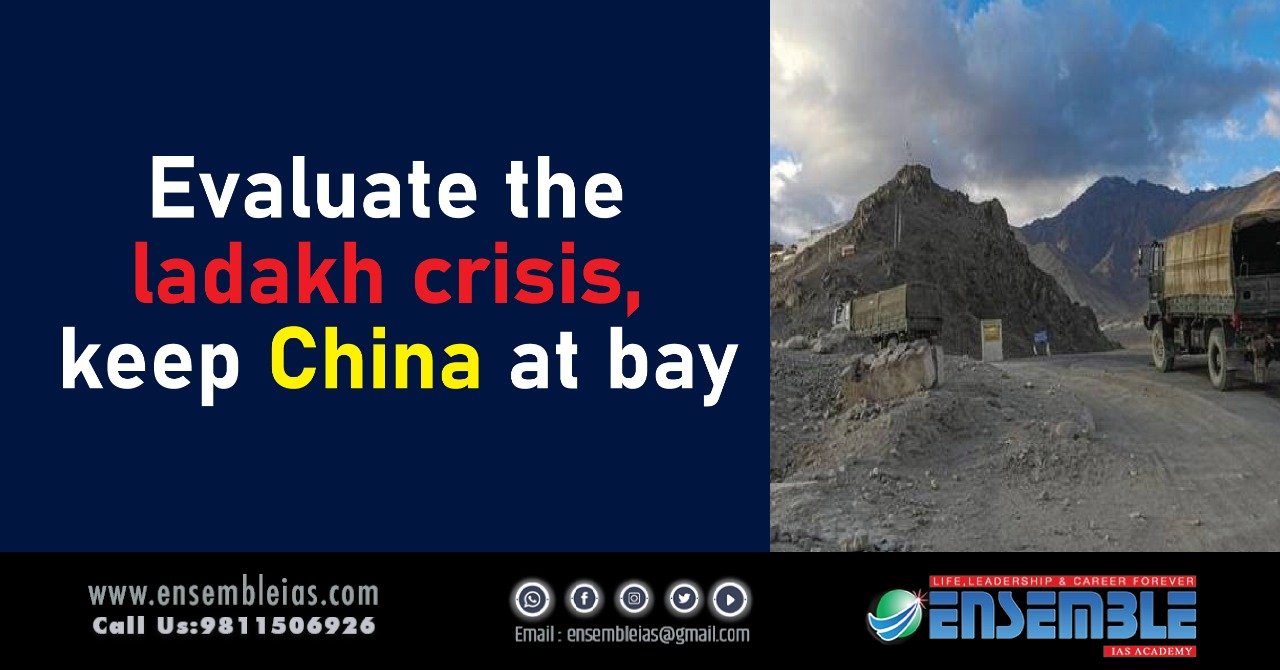Evaluate the Ladakh crisis, keep China at bay:
After over a year, the stand-off between Indian and Chinese troops in eastern Ladakh shows no signs of resolution. Disengagement has stalled, China continues to reinforce its troops, and talks have been fruitless.
To buy our online courses: Click Here
More broadly, the India-China bilateral relationship has ruptured. Political relations are marked by hostility and distrust. Reversing a long-held policy, New Delhi will no longer overlook the problematic border dispute for the sake of a potentially lucrative wider relationship; now, as India’s External Affairs Minister S. Jaishankar has made clear, the relationship is conditional on quietude on the border.
Even if — a big if — disengagement continues, the relationship will remain vulnerable to destabilising disruptions. On the Line of Actual Control (LAC) and beyond, India’s military and political leaders will need to learn the right lessons from Ladakh, to ensure they are better postured to meet the challenge of Chinese coercion.
Study and findings
In a recent study published by the Lowy Institute — The crisis after the crisis: how Ladakh will shape India’s competition with China — this writer has argued that the Ladakh crisis offers New Delhi three key lessons in managing the intensifying strategic competition with China.
Revamping strategies
First, military strategies based on denial are more useful than strategies based on punishment. The Indian military’s standing doctrine calls for deterring adversaries with the threat of massive punitive retaliation for any aggression, capturing enemy territory as bargaining leverage in post-war talks. But this did not deter China from launching unprecedented incursions in May 2020, and the threat lost credibility when retaliation never materialised.
In contrast, the Indian military’s high-water mark in the crisis was an act of denial — its occupation of the heights on the Kailash Range on its side of the LAC in late August. This action served to deny that key terrain to the Chinese People’s Liberation Army (PLA), and gave the Indian Army a stronger defensive position from which it could credibly defend a larger segment of its front line.
A doctrinal focus on denial will give the Indian military greater capacity to thwart future land grabs across the LAC. By bolstering India’s defensive position, rather than launching an escalatory response, such a strategy is also more likely than punishment to preserve crisis stability. Over time, improved denial capabilities may allow India to reduce the resource drain of the increased militarisation of the LAC.
Evaluate the Ladakh crisis keep China at bay:
Political costs
The second key lesson of Ladakh is that China is more likely to be deterred or coerced with the threat of political costs, rather than material costs. Admittedly, the Chinese military’s deployment to the LAC was also large and extremely expensive. But China’s defence budget is three to four times larger than India’s, and its Western Theatre Command boasts over 200,000 soldiers. The material burden of the crisis would not disrupt its existing priorities.
In contrast, India successfully raised the risks of the crisis for China through its threat of a political rupture, not military punishment. A permanently hostile India or an accidental escalation to conflict were risks that China, having achieved its tactical goals in the crisis, assessed were an unnecessary additional burden while it was contending with the instability of its territorial disputes and pandemic response.
The corollary lesson is that individual powers, even large powers such as India, will probably struggle to shift Beijing’s calculus alone. To the extent that China adjusted its position in the Ladakh crisis, it did so because it was responding to the cumulative effect of multiple pressure points — most of which were out of India’s control. Against the rising behemoth, only coordinated or collective action is likely to be effective.
Indian Ocean Region is key
The third lesson of Ladakh — and possibly the hardest to address — is that India should consider accepting more risk on the LAC in exchange for long-term leverage and influence in the Indian Ocean Region. From the perspective of long-term strategic competition, the future of the Indian Ocean Region is more consequential and more uncertain than the Himalayan frontier.
At the land border, the difficult terrain and more even balance of military force means that each side could only eke out minor, strategically modest gains at best. In contrast, India has traditionally been the dominant power in the Indian Ocean Region and stands to cede significant political influence and security if it fails to answer the dizzyingly rapid expansion of Chinese military power.
The Ladakh crisis, by prompting an increased militarisation of the LAC, may prompt India to defer long-overdue military modernisation and maritime expansion into the Indian Ocean. To keep its eyes on the prize, New Delhi will have to make tough-minded strategic trade-offs, deliberately prioritising military modernisation and joint force projection over the ground-centric combat arms formations required to defend territory.
This will be a politically formidable task — blood has now been spilled on the LAC, and for domestic political reasons, India cannot be seen to be passive on the border. Rebalancing India’s strategic priorities will require the central government, through the Chief of Defence Staff, to issue firm strategic guidance to the military services. This response will be a test not only of the government’s strategic sense and far-sightedness, but also of the ability of the national security apparatus to overcome entrenched bureaucratic and organisational-cultural biases.
Also Read: China’s population growth slows to lowest rate in decades
As these three lessons show, the future of the strategic competition is not yet written. Thus far, India has suffered unequal strategic costs from the Ladakh crisis. Chinese troops continue to camp on previously Indian-controlled land, and worse, India may jeopardise its long-term leverage in the more consequential Indian Ocean Region. But if India’s leaders honestly and critically evaluate the crisis, it may yet help to actually brace India’s long-term position against China.
(Evaluate the Ladakh crisis keep China at bay)




